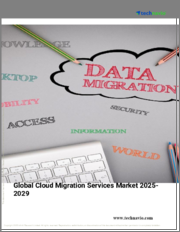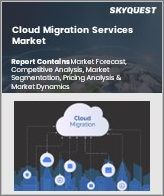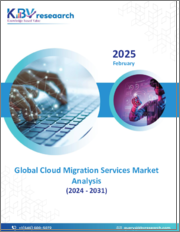
|
시장보고서
상품코드
1733249
세계의 클라우드 마이그레이션 시장 : 전개 유형, 업계별, 지역별(2026-2032년)Cloud Migration Market By Deployment Type (Public Cloud, Private Cloud), Vertical (Telecommunications And IT, Manufacturing), & Region for 2026-2032 |
||||||
클라우드 마이그레이션 시장 평가(2026-2032년)
원격 근무가 증가함에 따라 원활한 협업을 지원하는 클라우드 기반 도구와 플랫폼에 대한 요구가 증가하면서 클라우드 마이그레이션의 채택이 증가하고 있습니다. 클라우드 솔루션은 확장 가능한 리소스와 유연한 인프라를 제공하기 때문에 기업은 변화하는 비즈니스 요구와 성장에 빠르게 대응할 수 있습니다. 이에 따라 시장 규모는 2024년 190억 3,000만 달러를 돌파하고 2032년에는 약 1,031억 3,000만 달러에 달할 것으로 예측됩니다.
이와 더불어, 클라우드 제공업체가 제공하는 고급 보안 기능과 컴플라이언스 인증이 데이터 보호 및 규정 준수를 강화하고자 하는 기업들에게 어필하면서 2026년부터 2032년까지 23.52%의 연평균 복합 성장률(CAGR)로 시장이 성장할 것으로 예측됩니다.
클라우드 마이그레이션 시장 정의/개요
클라우드 마이그레이션은 데이터, 용도, 기타 비즈니스 요소를 On-Premise 인프라에서 클라우드 기반 환경으로 이전하는 과정을 말합니다. 이 마이그레이션에는 IaaS(Infrastructure as a Service), PaaS(Platform as a Service), SaaS(Software as a Service) 등의 클라우드 서비스로의 워크로드 전환이 포함됩니다. 그 목적은 확장성, 유연성, 비용 효율성 향상 등 클라우드의 장점을 활용하는 것입니다.
다양한 분야의 조직이 클라우드 마이그레이션을 활용하여 업무 효율성을 개선하고 현대의 기술 수요에 적응하고 있습니다. 클라우드 마이그레이션의 용도에는 엔터프라이즈 용도, 데이터 스토리지 솔루션, 비즈니스 분석 플랫폼의 클라우드 마이그레이션이 포함됩니다. 이러한 마이그레이션은 원격 근무 기능을 지원하고, 실시간 협업을 가능하게 하며, 재해복구 프로세스를 강화하여 비즈니스 민첩성과 생산성을 향상시킬 수 있습니다.
업계 전반의 디지털 전환 전략 채택 증가는 클라우드 마이그레이션의 채택을 어떻게 증가시킬 것인가?
클라우드 마이그레이션 시장은 산업 전반에 걸쳐 디지털 전환 전략의 채택이 증가함에 따라 빠르게 성장하고 있습니다. 기업들은 확장성, 유연성, 비용 효율성 향상 등 용도과 데이터를 클라우드로 마이그레이션할 경우 얻을 수 있는 이점을 인식하고 있습니다. 미국 정부회계책임국에 따르면, 연방정부 기관만 2023 회계연도에 78억 달러 이상을 클라우드 서비스에 지출할 계획으로, 정부 기관은 모든 부문에 걸쳐 클라우드 도입에 많은 투자를할 것으로 예상하고 있습니다.
보안 및 컴플라이언스 요구 사항도 클라우드 마이그레이션 시장을 주도하고 있습니다. 사이버 위협이 진화함에 따라 기업들은 고급 보안 기능과 규제 준수 지원을 위해 클라우드 제공업체를 이용하고 있습니다. 클라우드는 강력한 데이터 보호 조치를 제공하고 기업이 엄격한 데이터 프라이버시 규제를 충족할 수 있도록 돕습니다. 최근 마이크로소프트는 미국 정보기관을 지원하기 위해 Azure Government Secret 클라우드 리전 확장을 발표하며 기밀 데이터에 대한 안전한 클라우드 솔루션에 대한 중요성이 커지고 있음을 보여주었습니다.
비즈니스 연속성 및 재해복구 솔루션의 필요성도 클라우드 마이그레이션을 촉진하는 중요한 요인 중 하나입니다. 클라우드 기반 백업 및 복구 서비스는 시스템 장애나 자연재해 발생 시 조직에 안정적인 데이터 보호와 신속한 복구 기능을 제공합니다. 유럽 연합 사이버 보안 기관(ENISA)은 2022년 조직의 46%가 하드웨어 장애로 인한 데이터 유출 및 다운타임을 경험했다고 보고했으며, 이는 강력한 클라우드 기반 재해복구 솔루션의 중요성을 강조하고 있습니다.
클라우드 마이그레이션에 따른 다운타임과 서비스 중단 문제는 시장 성장을 저해할까?
클라우드 마이그레이션의 주요 억제요인 중 하나는 데이터 보안과 프라이버시에 대한 우려입니다. 기업들은 민감한 정보를 클라우드 환경의 오프사이트에 저장할 경우, 잠재적인 침해 및 무단 액세스에 노출될 수 있다는 점을 우려하는 경우가 많습니다. 강력한 보안 조치와 규제 준수를 보장하는 것은 클라우드 마이그레이션 결정을 방해하는 중요한 문제입니다.
클라우드 서비스를 레거시 시스템과 통합하는 것은 복잡하고 시간이 많이 걸립니다. 많은 기업들은 복잡한 IT 인프라를 가지고 있으며, 기존 업무를 중단하지 않고 클라우드 솔루션과 원활하게 통합하는 것은 기술적인 문제가 될 수 있습니다. 이러한 통합 문제는 마이그레이션 프로세스를 지연시키거나 복잡하게 만들 수 있습니다.
마이그레이션 프로세스 중에는 다운타임이나 서비스 중단의 위험이 있어 업무에 영향을 미칠 수 있습니다. 클라우드 마이그레이션 시 혼란을 최소화하기 위해서는 치밀한 계획과 실행이 필요합니다. 다운타임의 가능성은 생산성과 고객 만족도에 영향을 미치기 때문에 기업은 클라우드 마이그레이션에 신중을 기하게 됩니다.
목차
제1장 세계의 클라우드 마이그레이션 시장 서론
- 시장 개요
- 조사 범위
- 전제조건
제2장 주요 요약
제3장 VERIFIED MARKET RESEARCH의 조사 방법
- 데이터 마이닝
- 밸리데이션
- 1차 자료
- 데이터 소스 리스트
제4장 세계의 클라우드 마이그레이션 시장 전망
- 개요
- 시장 역학
- 성장 촉진요인
- 성장 억제요인
- 기회
- Porter's Five Forces 모델
- 밸류체인 분석
제5장 세계의 클라우드 마이그레이션 시장, 전개 유형별
- 개요
- 퍼블릭 클라우드
- 프라이빗 클라우드
- 하이브리드 클라우드
제6장 세계의 클라우드 마이그레이션 시장 : 업계별
- 개요
- 은행, 금융서비스 및 보험(BFSI)
- IT 및 통신
- 교육
- 제조업
- 기타
제7장 세계의 클라우드 마이그레이션 시장, 지역별
- 개요
- 북미
- 미국
- 캐나다
- 멕시코
- 유럽
- 독일
- 영국
- 프랑스
- 기타 유럽
- 아시아태평양
- 중국
- 일본
- 인도
- 기타 아시아태평양
- 세계 기타 지역
- 라틴아메리카
- 중동 및 아프리카
제8장 세계의 클라우드 마이그레이션 시장 경쟁 구도
- 개요
- 기업의 시장 순위
- 주요 발전 전략
제9장 기업 개요
- Amazon Web Services, Inc.
- Cloudflare, Inc.
- NTT Data
- IBM
- Sumo Logic
- Openstack
- Cisco Systems
- VMware
제10장 부록
- 관련 조사
Cloud Migration Market Valuation - 2026-2032
The rise of remote work has increased the need for cloud-based tools and platforms that support seamless collaboration is propelling the adoption of cloud migration. Cloud solutions offer scalable resources and flexible infrastructure, allowing companies to quickly adapt to changing business needs and growth, this is driving the market size surpass USD 19.03 Billion valued in 2024 to reach a valuation of around USD 103.13 Billion by 2032.
In addition to this, advanced security features and compliance certifications offered by cloud providers appeal to organizations looking to strengthen their data protection and regulatory adherence, this is enabling the market to grow at a CAGR of 23.52% from 2026 to 2032.
Cloud Migration Market: Definition/ Overview
Cloud migration refers to the process of moving data, applications, and other business elements from on-premises infrastructure to a cloud-based environment. This shift involves transferring workloads to cloud services such as Infrastructure as a Service (IaaS), Platform as a Service (PaaS), or Software as a Service (SaaS). The goal is to leverage the cloud's benefits, including enhanced scalability, flexibility, and cost efficiency.
Organizations across various sectors utilize cloud migration to improve operational efficiency and adapt to modern technological demands. Applications of cloud migration include moving enterprise applications, data storage solutions, and business analytics platforms to the cloud. This transition supports remote work capabilities, enables real-time collaboration, and enhances disaster recovery processes, thus driving greater agility and productivity in business operations.
How will Rising Adoption of Digital Transformation Strategies across Industries Increase Adoption of Cloud Migration?
The cloud migration market is experiencing rapid growth, driven by the increasing adoption of digital transformation strategies across industries. Organizations are recognizing the benefits of moving their applications and data to the cloud, including enhanced scalability, flexibility, and cost-efficiency. According to the U.S. Government Accountability Office, federal agencies alone planned to spend over USD 7.8 Billion on cloud services in fiscal year 2023, highlighting the significant investment in cloud adoption across sectors.
Security and compliance requirements are also propelling the cloud migration market forward. As cyber threats evolve, businesses are turning to cloud providers for advanced security features and regulatory compliance support. The cloud offers robust data protection measures and helps organizations meet stringent data privacy regulations. Recently, Microsoft announced the expansion of its Azure Government Secret cloud region to support the U.S. Intelligence Community, demonstrating the growing emphasis on secure cloud solutions for sensitive data.
The need for business continuity and disaster recovery solutions is another key driver of cloud migration. Cloud-based backup and recovery services provide organizations with reliable data protection and rapid recovery capabilities in the event of system failures or natural disasters. The European Union Agency for Cybersecurity (ENISA) reported that 46% of organizations experienced data loss or downtime due to hardware failures in 2022, underscoring the importance of robust cloud-based disaster recovery solutions.
Will Downtime and Service Disruptions Issues of Cloud Migration Restraining the Market Growth?
One of the major restraints of cloud migration is the apprehension about data security and privacy. Organizations often worry about exposing sensitive information to potential breaches or unauthorized access when it is stored off-site in a cloud environment. Ensuring robust security measures and compliance with regulations is a significant concern that can hinder the decision to migrate to the cloud.
Integrating cloud services with legacy systems can be complex and time-consuming. Many businesses have intricate IT infrastructures, and ensuring seamless integration with cloud solutions without disrupting existing operations can present technical challenges. These integration issues can delay or complicate the migration process.
During the migration process, there is a risk of downtime or service disruptions, which can impact business operations. Ensuring minimal disruption while transitioning to the cloud requires meticulous planning and execution. Potential downtime can affect productivity and customer satisfaction, making businesses cautious about undertaking cloud migration.
Category-Wise Acumens
Which Factors Enable Public Cloud Segment Dominate Cloud Migration Market?
The public cloud segment is dominating the cloud migration market, driven by its scalability, cost-effectiveness, and ease of implementation. Organizations are increasingly adopting public cloud services to modernize their IT infrastructure and leverage advanced technologies such as artificial intelligence and machine learning. According to the U.S. Government Accountability Office, federal agencies' use of public cloud services increased by 60% between fiscal years 2015 and 2019, demonstrating the growing preference for public cloud solutions across sectors.
Public cloud providers are continuously expanding their service offerings and global infrastructure to meet the diverse needs of businesses. These platforms offer a wide range of services, from basic storage and computing to advanced analytics and serverless computing, enabling organizations to innovate rapidly. Recently, Google Cloud announced the expansion of its global network with new regions in Malaysia, Thailand, and New Zealand, further strengthening its position in the Asia-Pacific market and providing businesses with more options for data residency and reduced latency.
Which Factors Enhance the Use of Cloud Migration in Banking, Financial Services, and Insurance (BFSI) Sector?
The Banking, Financial Services, and Insurance (BFSI) sector is leading the charge in cloud migration, driven by the need for digital transformation, enhanced customer experiences, and improved operational efficiency. Financial institutions are leveraging cloud technologies to modernize their core systems, develop innovative products, and streamline processes. According to the U.S. Federal Reserve's 2022 report on bank technology, 82% of surveyed banks indicated that they were using or considering using public cloud services, highlighting the sector's growing reliance on cloud solutions.
Cloud migration in BFSI is also fueled by the increasing demand for real-time data analytics, risk management, and regulatory compliance. Cloud platforms offer advanced analytics capabilities and scalable infrastructure that enable financial institutions to process vast amounts of data and gain actionable insights. Recently, JPMorgan Chase announced a partnership with Google Cloud to enhance its risk management and trading systems, demonstrating the ongoing shift towards cloud-based solutions in critical financial operations.
Country/Region-wise Acumens
Will Presence of Major Cloud Service Providers in North America Mature Cloud Migration Market?
North America is dominating the cloud migration market, driven by widespread digital transformation initiatives, a robust technology ecosystem, and significant investments in cloud infrastructure. The region's mature IT landscape and early adoption of cloud technologies have positioned it as a leader in cloud migration. According to the U.S. Government Accountability Office, federal agencies alone planned to spend approximately USD 7.8 Billion on cloud services in fiscal year 2023, underlining the substantial investment in cloud adoption across both public and private sectors in North America.
The presence of major cloud service providers and a highly skilled workforce further solidifies North America's dominance in the cloud migration market. These factors contribute to the rapid development and adoption of innovative cloud solutions across various industries. Recently, Amazon Web Services (AWS) announced the expansion of its Local Zones in major U.S. cities, bringing cloud infrastructure closer to end-users and enabling low-latency applications. This move demonstrates the ongoing efforts to enhance cloud capabilities and meet the growing demand for edge computing solutions in the region.
Will Increasing Internet Penetration Enhance Adoption of Cloud Migration in Asia Pacific?
The Asia Pacific region is experiencing rapid growth in the cloud migration market, driven by digital transformation initiatives, increasing internet penetration, and supportive government policies. Countries across the region are embracing cloud technologies to enhance their competitiveness and drive economic growth. According to the Australian Government's Digital Transformation Agency, 75% of IT workloads across the Australian government will be hosted on public cloud services by 2025, reflecting the strong push towards cloud adoption in the region.
Small and medium-sized enterprises (SMEs) in Asia Pacific are increasingly turning to cloud solutions to level the playing field with larger competitors, fueling market growth. Cloud migration enables these businesses to access advanced technologies and scale their operations without significant upfront investments. Recently, Alibaba Cloud announced the launch of its first data center in the Philippines, expanding its presence in Southeast Asia and providing local businesses with easier access to cloud services.
Competitive Landscape
The cloud migration market is a dynamic and competitive space, characterized by a diverse range of players vying for market share. These players are on the run for solidifying their presence through the adoption of strategic plans such as collaborations, mergers, acquisitions, and political support.
The organizations are focusing on innovating their product line to serve the vast population in diverse regions. Some of the prominent players operating in the cloud migration market include:
- Amazon Web Services (AWS)
- Microsoft Azure
- Google Cloud Platform (GCP)
- IBM Cloud
- Oracle Cloud
- Salesforce
- Alibaba Cloud
- VMware
- Cisco
- Hewlett Packard Enterprise (HPE)
- Rackspace Technology
- SAP
- Red Hat
- Nutanix
- Dell Technologies
- ServiceNow
- Palo Alto Networks
- Cloudflare
- TIBCO Software
- Box
Latest Developments
- In August 2024, Microsoft and Amazon Web Services (AWS) announced a new alliance to streamline multi-cloud strategies for enterprises, integrating advanced analytics and AI capabilities to enhance migration efficiency and reduce operational costs.
- In September 2024, Google Cloud introduced a suite of tools designed to simplify and accelerate cloud migration for small to medium-sized businesses, featuring automated assessment and optimization features to ensure a smooth transition.
Cloud Migration Market, By Category
- Deployment Type:
- Public Cloud
- Private Cloud
- Hybrid Cloud
- End-User Industry:
- Banking, Financial Services, and Insurance
- Telecommunications and IT
- Manufacturing
- Education
- Region:
- North America
- Europe
- Asia-Pacific
- South America
- Middle East & Africa
TABLE OF CONTENTS
1 INTRODUCTION OF GLOBAL CLOUD MIGRATION MARKET
- 1.1 Overview of the Market
- 1.2 Scope of Report
- 1.3 Assumptions
2 EXECUTIVE SUMMARY
3 RESEARCH METHODOLOGY OF VERIFIED MARKET RESEARCH
- 3.1 Data Mining
- 3.2 Validation
- 3.3 Primary Interviews
- 3.4 List of Data Sources
4 GLOBAL CLOUD MIGRATION MARKET OUTLOOK
- 4.1 Overview
- 4.2 Market Dynamics
- 4.2.1 Drivers
- 4.2.2 Restraints
- 4.2.3 Opportunities
- 4.3 Porters Five Force Model
- 4.4 Value Chain Analysis
5 GLOBAL CLOUD MIGRATION MARKET, BY DEPLOYMENT TYPE
- 5.1 Overview
- 5.2 Public Cloud
- 5.3 Private Cloud
- 5.4 Hybrid Cloud
6 GLOBAL CLOUD MIGRATION MARKET, BY End-User Industry
- 6.1 Overview
- 6.2 Banking, Financial Services, and Insurance
- 6.3 Telecommunications and IT
- 6.4 Education
- 6.5 Manufacturing
- 6.6 Others
7 GLOBAL CLOUD MIGRATION MARKET, BY GEOGRAPHY
- 7.1 Overview
- 7.2 North America
- 7.2.1 U.S.
- 7.2.2 Canada
- 7.2.3 Mexico
- 7.3 Europe
- 7.3.1 Germany
- 7.3.2 U.K.
- 7.3.3 France
- 7.3.4 Rest of Europe
- 7.4 Asia Pacific
- 7.4.1 China
- 7.4.2 Japan
- 7.4.3 India
- 7.4.4 Rest of Asia Pacific
- 7.5 Rest of the World
- 7.5.1 Latin America
- 7.5.2 Middle East And Africa
8 GLOBAL CLOUD MIGRATION MARKET COMPETITIVE LANDSCAPE
- 8.1 Overview
- 8.2 Company Market Ranking
- 8.3 Key Development Strategies
9 COMPANY PROFILES
- 9.1 Amazon Web Services, Inc.
- 9.1.1 Overview
- 9.1.2 Financial Performance
- 9.1.3 Product Outlook
- 9.1.4 Key Developments
- 9.2 Cloudflare, Inc.
- 9.2.1 Overview
- 9.2.2 Financial Performance
- 9.2.3 Product Outlook
- 9.2.4 Key Developments
- 9.3 NTT Data
- 9.3.1 Overview
- 9.3.2 Financial Performance
- 9.3.3 Product Outlook
- 9.3.4 Key Developments
- 9.4 IBM
- 9.4.1 Overview
- 9.4.2 Financial Performance
- 9.4.3 Product Outlook
- 9.4.4 Key Developments
- 9.5 Sumo Logic
- 9.5.1 Overview
- 9.5.2 Financial Performance
- 9.5.3 Product Outlook
- 9.5.4 Key Developments
- 9.6 Openstack
- 9.6.1 Overview
- 9.6.2 Financial Performance
- 9.6.3 Product Outlook
- 9.6.4 Key Developments
- 9.7 Cisco Systems
- 9.7.1 Overview
- 9.7.2 Financial Performance
- 9.7.3 Product Outlook
- 9.7.4 Key Developments
- 9.8 VMware
- 9.8.1 Overview
- 9.8.2 Financial Performance
- 9.8.3 Product Outlook
- 9.8.4 Key Developments
10 Appendix
- 10.1 Related Research



















